
- UD grad interns help preserve mummies, spacesuit, other cultural treasures
- Bringing a saintly portrait back to life in Missouri
- Conserving a knight's shield from ages past
- Käsebier photographs conserved at National Gallery of Canada
- Examining ancient Egyptian mummies at the Walters Art Museum
- Restoring Southwestern pottery at the Arizona State Museum
- Caring for Maryland's first settlement, Armstrong's spacesuit
- Preserving masterpieces at the Walters Art Museum
- 'Big Four' railroad magnate's paintings undergo conservation at Yale
- Studying indigo dyes at the Smithsonian
- Treating a Moorish Islamic ceiling at the Metropolitan Museum of Art
Editor's note: The Winterthur/University of Delaware Program in Art Conservation is one of only five graduate-level conservation programs in the United States. Graduate students in the program spend their third year in an advanced internship at museums and studios around the world.
Here, Louise Marie Orsini reports on her work at the Walters Art Museum in Baltimore.
10:19 a.m., March 19, 2009----My third-year internship at the Walters Art Museum in Baltimore includes research, examination and treatment of three paintings from the permanent collection. These works are Damascus by Alberto Pasini (1826-1899), Portrait of Pope Pius the V by Bartolomeo Passerotti (1529-1592), and a panel St. John by Vittore Crivelli (1440-1501). These wide-ranging artists and periods are representative of WAM's collection.
Internship activities at WAM also include the conservation of frames, the couriering of paintings, the examination of incoming and outgoing works for loans, and short-term treatment projects such as the consolidation of Virgin and Child with Saints by Giovanni di Paolo and the grime reduction carried out on Christ Weeping over Jerusalem by Ary Scheffer, just to name a few.
My treatment experience while at WAM will range from structural and aesthetic to preventive. WAM has analytical abilities in X-radiography, infrared reflectography, X-ray fluorescence (XRF), cross-section analysis, and polarized light microscopy. These analytical techniques will be used in tandem with research and discussion with WAM's curators to determine the best possible treatment options for preserving the museum's masterpieces.
The Walters' conservation staff is composed of conservators trained in the United States, England, Scotland and Spain. This international collection of conservation professionals fuels an ongoing exchange of treatment techniques as well as discussions of how conservation should impact the aesthetic of a work, especially when it comes to inpainting methods chosen and varnish removal/reduction.



